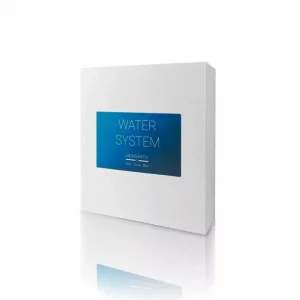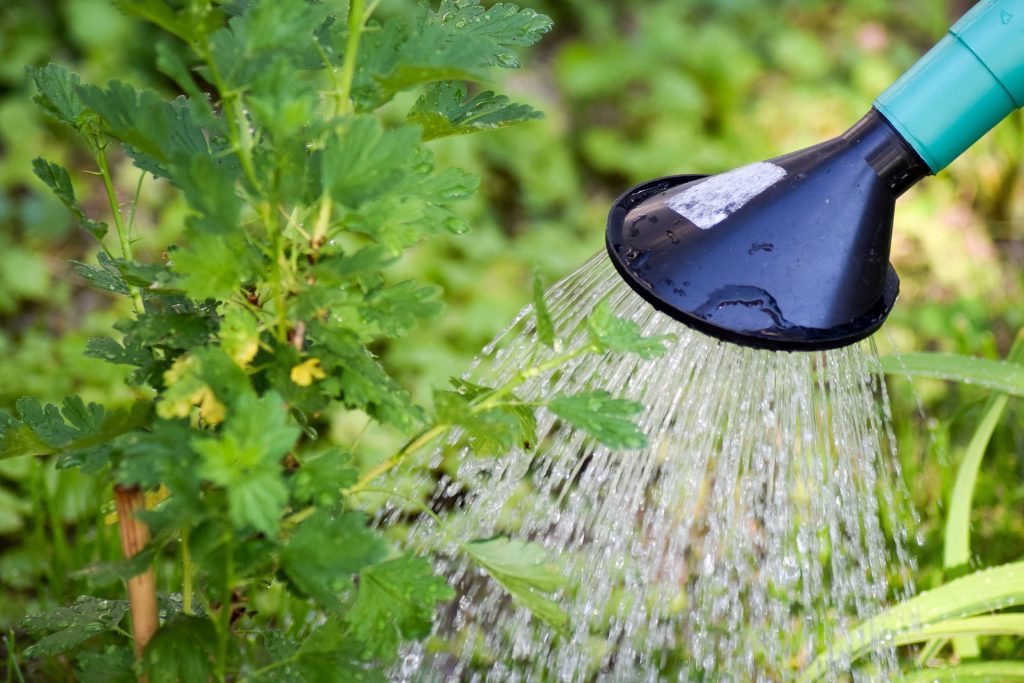If you know how to water your favorite plant properly, you can avoid a few mistakes when growing. As many novice growers are afraid of the plant drying out, they provide it with sufficient water. But be careful! Overwatering is one of the most common mistakes when watering plants. The saying “more is more” is therefore wrong in this context. In the following, we explain when, how often and with which water you should water your plants.
If you are using one of our Bonsanto Mini Grow Boxes to grow your favorite plant, the only knowledge you need is our Bonsanto growing instructions. The advantage of using Bonsanto components is that you do not need a PH meter, EC meter, temperature or humidity meter. This makes your work much easier when growing the plant. Bonsanto components such as fertilizer, soil and grow box are very beginner-friendly.
If you do not have a grow box from Bonsanto, the following information is relevant for you.
Inhaltsverzeichnis
What do plants need water for?
Water is vital for your plants for several reasons. Firstly, plants need water for the process of photosynthesis, and secondly, water acts as a nutrient transporter, helping the plant to draw important nutrients from the soil. Furthermore, water supports the temperature regulation of a plant.
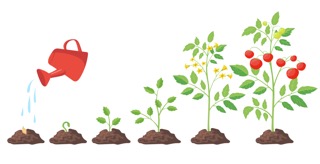
When and how should plants be watered?
There is a simple rule of thumb for knowing when it is the right time to water the plant. The plant needs new water when approximately the first 1-2 cm of the soil surface has dried. You can easily check whether this is the case with your finger or a ruler. When growing indoors, we also recommend watering the plant before switching on the lights.
How much water your plant needs depends on various factors. If your plant is in the seedling stage, it is best to use a spray bottle for watering, as the water requirement is quite low at this stage. If you would like to know more about your plants in the seedling stage, take a look at our blog article “How to germinate seeds”. Furthermore, the larger the plant and the larger the pot, the greater the water requirement.
When watering plants, you should also be careful not to pour the water into the pot all at once. We recommend dividing the water into portions and gradually pouring it into the pot. You can leave a few minutes between portions. In addition, distribute the water as evenly as possible throughout the pot. The soil around the edge of the pot should not remain dry either. Dry spots can hinder your plant’s water uptake.
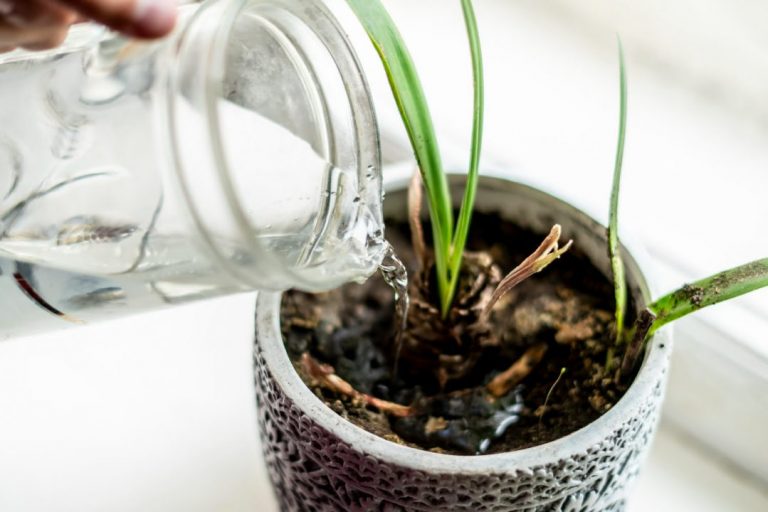
How can you recognize good water quality?
To find suitable water for watering plants, you should consider the following criteria. If you use a Bonsanto grow box for cultivation, you have the great advantage that you do not need to pay any further attention to this paragraph. The Bonsanto soil regulates the temperature, EC and pH value of the water as well as the water hardness. This means you don’t need any measuring devices and can use any water to water your favorite plant. In this case, please refer to our Bonsanto growing instructions.
If you don’t own a Bonsanto grow box or are interested in the theory, consider the following:
Temperature
When watering plants, you should make sure that the water has a temperature of around 20 degrees Celsius. If you use water that is too cold or too hot, the roots of your plant may suffer from thermal shock.
EC value
The EC value of the water also contributes to healthy plant growth. EC stands for electrical conductivity and indicates the salt concentration in the water. You can prevent your plant from being over- or undersalted by ensuring that the EC value of the water does not exceed 0.5 when watering plants.
pH-value
The pH value indicates how acidic or alkaline a solution is. As the correct pH value supports the nutrient uptake of your cannabis plant, you should not use water with a pH value that is too high or too low. Cannabis plants like a slightly acidic grow environment, which is why the pH value of the water should be around 6.0 to 6.5.
Water hardness
Another factor that influences the quality of the water is the hardness of the water. The water hardness indicates the mineral content of the water, whereby hard water has a high concentration of minerals and soft water has a low concentration of minerals. When watering plants, you should use medium-hard water with a value of 140 – 210 ppm.
Which water sources are suitable for watering plants?
There are several sources of water that growers fall back on depending on their preference. Firstly, there is tap water, which is of course the cheapest and most convenient source of water. In most cases, however, European tap water has too high an EC and pH value. It is therefore essential to measure the temperature, EC and pH value of your tap water and, if it does not meet the necessary values for watering plants, fill it into a container. Then leave this in your home for several hours (e.g. overnight). This should cause the temperature of the water to adjust to the room temperature and the EC and pH values to drop. If both values are still too high despite aerating the water, you can lower the pH value with a pH-regulating solution and adjust the EC value by filtering the water.
Many growers also like to use still mineral water from the supermarket. But here, too, you should always check that the pH and EC values are correct and, if necessary, regulate the water so that it is suitable for watering plants. We advise against using rainwater for indoor growing! Rainwater often contains pollutants absorbed from the environment that could harm your grow. If you use the Bonsanto grow box, you can also save yourself the trouble of measuring, as the Bonsanto soil regulates these values itself. Everything you should follow when growing in the Bonsanto grow box can be found here
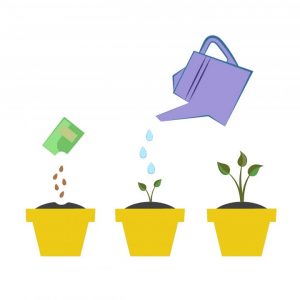
How do you recognize problems when watering plants?
There are two typical mistakes that occur again and again when watering plants. The most common problem when growing indoors is overwatering the plant. Overwatering drowns the roots of your plant so that the plant can no longer be supplied with sufficient oxygen. The problem of overwatering is difficult to remedy, so you should remember this: Less water is more! You can recognize overwatering by firm and drooping leaves, which are often yellowish in colour. If your plant is growing very slowly or not at all, this can be another sign of overwatering. If you have overwatered your plant, we recommend transplanting it into new soil and removing the rotten roots first. Always allow the soil to dry out before you start watering again!
If the leaves of your plant are brown, brittle and drooping, this is a sign of underwatering. To remedy underwatering, you should soak your plant in water. Remember to always water your plant when the top layer of soil is dry.
How to avoid overwatering?
An easy way to avoid overwatering is to choose the right potting soil. The Bonsanto Premium growing medium is beginner-friendly and contains perlite, which makes overwatering almost impossible and less harmful to your plant.
-
Pot with Saucer (3,2 Liters)
$2.39 incl. VAT Add to cart -
Bonsanto® Automated Irrigation System for Grow Box
Rated 4.50 out of 5$3.50 – $34.99Price range: $3.50 through $34.99 incl. VAT Select options This product has multiple variants. The options may be chosen on the product page
General tips at a glance:
- The water should be at room temperature for watering plants
- Pour the water before switching on the lights
- Water the plant slowly, not all at once
- Only water the plant when the top layer of soil is dry
- Avoid underwatering and overwatering
- Optional: Check the quality of the water before watering the plants if you don’t have a Bonsanto grow box
- Follow our growing instructions when growing in the Bonsanto grow box.
Now nothing should go wrong when watering plants!

